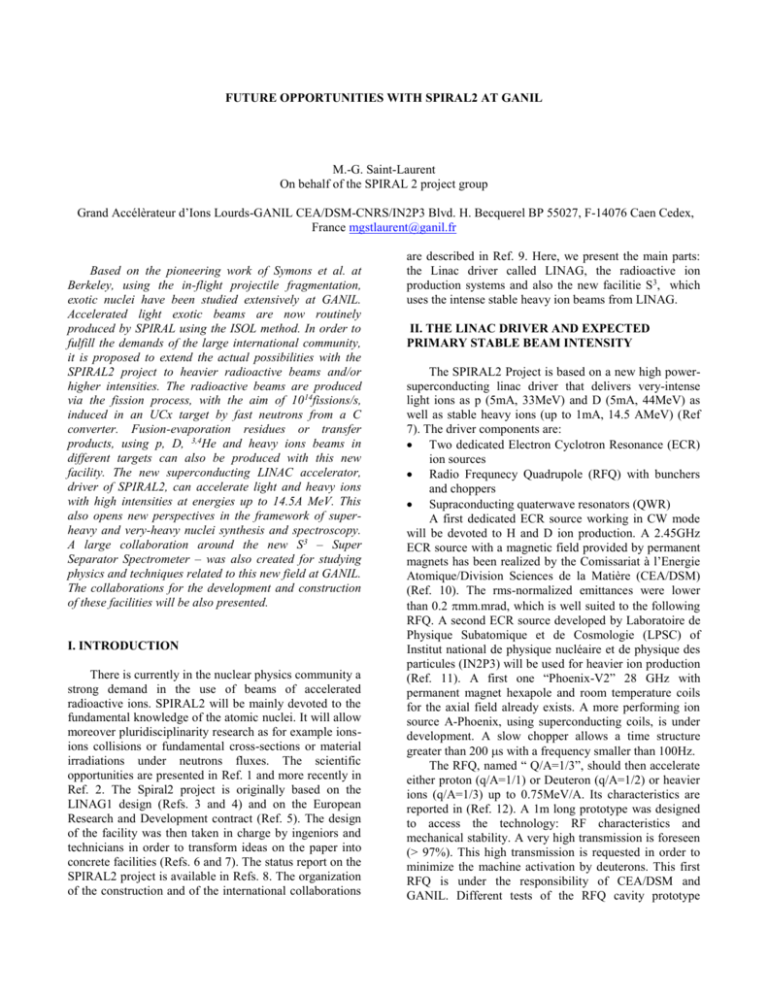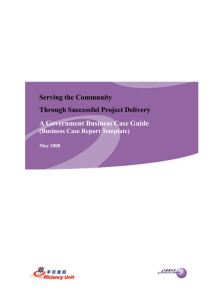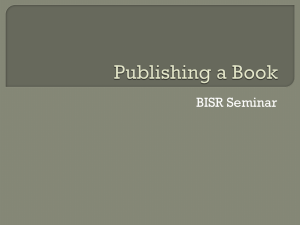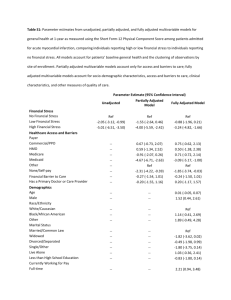AccApp07_manuscriptV4
advertisement

FUTURE OPPORTUNITIES WITH SPIRAL2 AT GANIL M.-G. Saint-Laurent On behalf of the SPIRAL 2 project group Grand Accélèrateur d’Ions Lourds-GANIL CEA/DSM-CNRS/IN2P3 Blvd. H. Becquerel BP 55027, F-14076 Caen Cedex, France mgstlaurent@ganil.fr Based on the pioneering work of Symons et al. at Berkeley, using the in-flight projectile fragmentation, exotic nuclei have been studied extensively at GANIL. Accelerated light exotic beams are now routinely produced by SPIRAL using the ISOL method. In order to fulfill the demands of the large international community, it is proposed to extend the actual possibilities with the SPIRAL2 project to heavier radioactive beams and/or higher intensities. The radioactive beams are produced via the fission process, with the aim of 10 14fissions/s, induced in an UCx target by fast neutrons from a C converter. Fusion-evaporation residues or transfer products, using p, D, 3,4He and heavy ions beams in different targets can also be produced with this new facility. The new superconducting LINAC accelerator, driver of SPIRAL2, can accelerate light and heavy ions with high intensities at energies up to 14.5A MeV. This also opens new perspectives in the framework of superheavy and very-heavy nuclei synthesis and spectroscopy. A large collaboration around the new S 3 – Super Separator Spectrometer – was also created for studying physics and techniques related to this new field at GANIL. The collaborations for the development and construction of these facilities will be also presented. I. INTRODUCTION There is currently in the nuclear physics community a strong demand in the use of beams of accelerated radioactive ions. SPIRAL2 will be mainly devoted to the fundamental knowledge of the atomic nuclei. It will allow moreover pluridisciplinarity research as for example ionsions collisions or fundamental cross-sections or material irradiations under neutrons fluxes. The scientific opportunities are presented in Ref. 1 and more recently in Ref. 2. The Spiral2 project is originally based on the LINAG1 design (Refs. 3 and 4) and on the European Research and Development contract (Ref. 5). The design of the facility was then taken in charge by ingeniors and technicians in order to transform ideas on the paper into concrete facilities (Refs. 6 and 7). The status report on the SPIRAL2 project is available in Refs. 8. The organization of the construction and of the international collaborations are described in Ref. 9. Here, we present the main parts: the Linac driver called LINAG, the radioactive ion production systems and also the new facilitie S3, which uses the intense stable heavy ion beams from LINAG. II. THE LINAC DRIVER AND EXPECTED PRIMARY STABLE BEAM INTENSITY The SPIRAL2 Project is based on a new high powersuperconducting linac driver that delivers very-intense light ions as p (5mA, 33MeV) and D (5mA, 44MeV) as well as stable heavy ions (up to 1mA, 14.5 AMeV) (Ref 7). The driver components are: Two dedicated Electron Cyclotron Resonance (ECR) ion sources Radio Frequnecy Quadrupole (RFQ) with bunchers and choppers Supraconducting quaterwave resonators (QWR) A first dedicated ECR source working in CW mode will be devoted to H and D ion production. A 2.45GHz ECR source with a magnetic field provided by permanent magnets has been realized by the Comissariat à l’Energie Atomique/Division Sciences de la Matière (CEA/DSM) (Ref. 10). The rms-normalized emittances were lower than 0.2 mm.mrad, which is well suited to the following RFQ. A second ECR source developed by Laboratoire de Physique Subatomique et de Cosmologie (LPSC) of Institut national de physique nucléaire et de physique des particules (IN2P3) will be used for heavier ion production (Ref. 11). A first one “Phoenix-V2” 28 GHz with permanent magnet hexapole and room temperature coils for the axial field already exists. A more performing ion source A-Phoenix, using superconducting coils, is under development. A slow chopper allows a time structure greater than 200 s with a frequency smaller than 100Hz. The RFQ, named “ Q/A=1/3”, should then accelerate either proton (q/A=1/1) or Deuteron (q/A=1/2) or heavier ions (q/A=1/3) up to 0.75MeV/A. Its characteristics are reported in (Ref. 12). A 1m long prototype was designed to access the technology: RF characteristics and mechanical stability. A very high transmission is foreseen (> 97%). This high transmission is requested in order to minimize the machine activation by deuterons. This first RFQ is under the responsibility of CEA/DSM and GANIL. Different tests of the RFQ cavity prototype including high power test at the Istituto Nazionale di Fisica Nucleare-Laboratori Nazionali del Sud (INFNLNS), vacuum, and cavity displacement at LPSC gives confidence for the realization of the 5m final RFQ (Ref. 13). Supraconducting cavities have taken benefit from precedent development at the Legnaro National Laboratory (INFN-LNL) for SPES, at Triumf for ISAC and at Argone National Laboratory (ANL) for RIA. The Linac section will use two different types of supraconducting cavities: a first section =0.07, in charge of CEA/DSM (Ref. 14) and a second one at higher velocity =0.12, in charge of Institut de Physique Nucléaire d’Orsay (IPNO) of IN2P3 (Ref. 15). Five QWR (2 prototypes and 3 pre-series) have been constructed. The two prototypes are tested showing excellent performances of the accelerating gradient and losses. The 3 pre-series are presently under test. The two first cryomodules are under construction. The RF coupler prototypes were developed by the LPSC Laboratory (Ref. 16). The expected gaseous ions yields are reported in figure 1 for Spiral2 using different solutions: V2-Phoenix or APhoenix sources and the RFQ A/Q=1/3. An important upgrade will be achieved using a new RFQ optimized at Q/A=1/6 instead of Q/A=1/3 [Memorandum of Understanding (MOU) with the ANL Laboratory]. Such a device will allow transmitting in the RFQ a more abundant ion charge state produced by the ion source for the heaviest elements. For comparison, the present performances of Ganil at about the same energy (13 AMeV at the exit of the CSS1 cyclotron) are also reported. Metallic beams are always more difficult to be produced than gaseous ones due to their reactivity. Best results in other projects leads expecting maxima intensities of 22 pµA 24Mg8+ , 10 pµA 40Ca13+ using the RFQ 1/3 and 16 pµA 40Ca7+ and 7 pµA 58Ni10+ using RFQ 1/6. Metallic developments are done in collaboration between GANIL and LPSC (Ref. 17). heavy ions is a powerful method to produce deficient nuclei as extensively used at the ISOL-Unilac facility (Ref. 20). The very intense heavy ions delivered by the SPIRAL2 LINAC allows us to expect the prodction of exotic nuclei with high intensity. It opens the possibility to complete their spectroscopy study in the low energy facility DESIR (Ref. 21), but also for the less exotic ones the acceleration possibility with the cyclotron CIME of SPIRAL1. The beam power deposition in thin target due to the very short heavy ion range (about 10m) constitutes, however, a difficult challenge. The aim is to gain a factor of 10-50 comparing to GSI-Unilac. Development in the continuation of the ISOL-UNILAC at SPIRAL2 is under the responsibility of the Centre d’Etudes Nucléaires de Bordeaux Gradignan (CENBG) of IN2P3. A first beam could be 94Ag by the reaction 40 Ca(4.75MeV/A)+28Si (about 2,4 mg/cm2). Another possibilities is the use of light particles (p, d, 3He) to produce intense radioactive beams near the stability line by transfer as done before at the Centre de Recherche du Cyclotron de Louvain-la-Neuve (CRC/LLN) (Ref. 22) or by fusion-evaporation as at Oakridge (Ref. 23). Development of intense 6He, 14,15O beams are done in collaboration with the SOREQ Nuclear Research Center (SOREQ-NRC) and the Weizmann Institute (WI) institute. In the following, we describe only the fission device. The goal to obtain D (5mA, 44 AMeV) and heavy stable ions (from He to Ca in a first step, then up to U in a second step, with intensities from 1pµA up to 1pmA) is well engaged. III. PRODUCTION OF RADIOACTIVE BEAMS BY THE ISOL METHOD Fig. 1. Expected intensities of stable heavy ion beams of gaseous elements at the exit of the LINAG accelerator for various versions (PHOENIX ion sources and RFQ). The multi-beam driver LINAC allows taking benefit of the different types of mechanisms to produce radioactive ions. The neutron rich ones will be produced by fission induced by neutrons as already performed at lower intensity at Tandar (Ref. 18 and Parnne2 (Ref. 19). Deep–inelastic induced by heavy ions could be also a more selective solution, as for example the reaction 86Kr (14.5MeV/A) + 208Pb, leading to N-rich nuclei along the neutron number N=50. Fusion-evaporation induced by The radioactive neutron rich beams will be mainly produced via the fission process, with the aim of 5.10 131014 fissions/s. One retained solution is the fast neutrons induced fission in a depleted UCx target. The neutrons (about 14 MeV, see fig 2) are generated by the break-up of 40MeV deuterons in a thick C target (converter), of sufficient thickness to prevent primary beam and charged particles from escaping. For such a high fission rate, the final converter should subtend 200kW. The converter study takes benefit of the SPES development at INFNLNL and BNPI-Novosibirsk: A first Carbon converter wheel was already tested with 50kW equivalent electron beam and a second one for 200kW is under calculation (Ref. 24). Others solutions are being studied as : H2O converter at the Laboratoire de Physique SUBAtomique et des TECHnologies associées (SUBATECH) of IN2P3, water-cooled Be at INFN-LNL, or Li Liquid at ANL, are still opened possible solutions for further optimization at 200kW. The energetic forward-going neutrons impinge on a thick production target of fissionable material. The geometry of the converter-target and the target size has been optimized (Ref. 25) using the MCNP code (Ref. 26): The target is placed inside a hot container. The sizes of 80mm diameter, 80mm length, at about 40mm from the entrance of the converter are a good compromise. It allows to produce in the target 5 1013 fissions/s with an UC depleted target of 11g/cm3 density. The target will be composed of 19 assemblies of about 60 disks (thickness of 1mm, diameter of 15mm, with a spacing of 0,3mm between each disk). Such modular target allows the construction on the same principle of shorter ones to favor rapidity instead of the in-target production. If a fission number constitutes a global indicator, the important parameter in fine is the available intensity for the user, and if possible a reduction of the total generated radioactivity. A large dimension external oven, made of Ta and using ohmic heating, is in development at IPNO in order to control and maintain the target temperature above 2000°C for efficient diffusion of fission products. Fig. 2. Expected neutrons fluxes after the Carbon converter. (Courtesy of X. Ledoux). The resulting fission products accumulate in the target, diffuse to the surface from which they evaporate towards an ion source. The efficiency is very depending on the chemical element that has to be produced and on the lifetime of isotope to be considered. For each element, diffusion depends critically on the micro and macro structure of the target material and on the temperature. Low density (about 3g/cm3) Uranium Carbide (UCx) targets are already routinely used at ISOLDE (Ref. 27) and Parnne2 (Ref. 19) with a microstructure of about 20 µm. The Gatchina laboratory developes target of higher density (about 11g/cm3) with various microstructure (200µm, 20µm, and soon 5µm) (Ref. 28). A collaboration, involving the Petersburg Nuclear Physics Institute (PNPI), INFN-LNL, IPNO and GANIL, investigates the UCX release properties at Gatchina: The high-density target with a 20µm microstructure shows a faster release than the 200µm one. Moreover, the release is of the same order of magnitude than for the lower density. This should allow providing potentially overall higher yields due to the higher density for the same target volume. As for the diffusion, the extracted ion yield is dependent on the chemical elements and the residence time inside the ion source. It’s why not only one universal ion source can be used. Four 1+ ion sources (Ref. 29) are for the moment retained for SPIRAL2 : An ECR 1+ “MONOBOB” for gaseous elements is already in test at GANIL (Ref. 30). Magnetic field is provided by coils witch are radiation hard: 10Sv/h at 1m from the target. A FEBIAD, « IRENA », well suited for shorted lifetime isotopes. Developement at IPNO focus on increasing the cathode lifetime of such a source (Ref. 31). An ionization surface source, well suited for alkali, is investigated at GANIL. The goal is to increase its duration in regard of the poisoning and wear of the ionizer. A Laser Ion source is particularly efficient for its selectivity and for metallic beam. An international collaboration has still to be constructed. It may be done in the context of a French ANR (Agence National de la Recherche), the EU 7th framework. Possibilities with Triumf and Mainz laboratories are also in progress. An off-line test bench is proposed in the hall D of GANIL. Cryoptraps are under development at GANIL in collaboration with IPNO, in order to catch volatile gaseous atoms witch are not ionized. The 1+ ions are then separated (1/300 separation) and charge bred in an ECR Ion source in order to be accelerated by the existing cyclotron CIME. The charge breeding is under development in LPSC (Ref. 32). The 1+/N+ adjustments have been tested off-line at LPSC, with noble and gaseous elements, with a good reproducibility. Tests are carried on for alkali and metallic elements. There is, to date, no facility using target comparable to the design goals of SPIRAL-II in running condition. Expected yields, after diffusion, ionization and acceleration, have been proposed in (Ref. 4) for few elements. Expected rate (see fig. 3) should be limited for safety reasons to intensities very dependent on the mass of the nuclei. Time constants for the release at such high temperature are not always measured and are very dependent of material, temperature, geometry, and coupling to the ion source. Only extrapolation from present running facilities is today possible. Those will have to be validate by increasing by steps the running conditions (primary intensity, target thickness…). Fig. 3. Expected intensities (to be validate by measurements) of fission fragments at SPIRAL2 after acceleration. A cut-off (depending of the isotope) will be done, corresponding to safety limitations. Another method is to let the beam to impinge directly on the fission target and to exit the target. This avoids unnecessary heating by the ions close to the end of their range (the Bragg peak), where the fission yield is negligible. The major drawback is certainly the lack of temperature control independent of the beam intensity and the fact that reduced deuteron intensity has to be used directly in UCx leading to less than 1013 fissions/s. However the reduced target thickness possible due to the short deuteron range could be in favor of a better diffusion for short lifetime nuclei or more refractory elements. UCx target for direct deuteron beam will be studied in the context of a MOU signed with Oakridge and ANL. Each new beam requests a dedicated R&D and not all the radioactive nuclei can be done as an accelerated radioactive beam. It’s in particular the case of refractory elements or very short lifetime nuclei. Another approach is then the in-flight method collecting fragments after a thin target. Rare events, either produced by reaction induced by very intense stable beams or issued from a secondary reaction with exotic ions produced in a first step reaction, constitutes a complementary alternative to the ISOL method. In this case, the target is thin enough to allow the fragments to come out of it. IV. PRODUCTION OF RARE NUCLEI BY THE INFLIGHT METHOD The multi-beam driver LINAC will increase the possibilities of the present GANIL facility, giving at term an important intensity upgrade at lower energy for heavy ions [see fig. 1]. A.C.C. Villari et al. (Ref. 33 and 34) proposes a Super Separator Spectrometer named S3. It will be set-up at the exit of the linear accelerator LINAG. The main qualities which are resqueted are : Target sustaining high intensity, Separation of very rare events from intense background. S3 will be made up of: A primary target (rotating cooled targets on a wheel, gas or liquid targets, defocalized beam about 2mm*20mm), A first separator that rejects the majority of the beam (primary beam suppression larger than 1012 and appropriate beam stopper), A focal point where a secondary target and/or a detection system can be installed, A second filter or spectrometer, A final focal plane where a performing detection system can be installed. Such a modular system is versatile, allowing (fig. 4) either: a) To filter in successive stages (two stages separators) fig4.a b) To perform secondary reactions fig 4.b c) To act as a pure spectrometer fig 4.c d) To filter with the possibility to put special device as for example the gas catcher and the trap of ANL [35] fig.4.d The case “a” is more dedicated to the synthesis of very and Super-heavy elements and the spectroscopy and chemistry of the most abundant ones. The case “b” allows for example Coulomb excitation study or a two steps reaction with allows going far away from stability. The S3 project gathers a wide international collaboration, including 23 teams (Ref. 36). Different working groups had written a Letter of Intent for the S3 project and related physics cases for the SPIRAL2 Scientific Advisory Committee. In a recent workshop, various subgroups have been formed in order to work on the different technical aspects of the S3 project: target, spectrometer, detection, physics cases. Cas a Separator 2. Spectrometer Beam Stopper 3. Cas b Separator 4. Spectrometer Beam Stopper 5. Spectrometer 6. Cas c Separator Beam Stopper Cas d Separator Spectrometer Gas Trap 7. Catcher Beam Stopper Fig. 4. Various possibilities of the Super Spectrometer Separator S3 (see text) 8. V. CONCLUSION SPIRAL-2 will be a second-generation machine for the long term if we consider the potential radioactive beam intensities and the required converter-target and radioactivity management (see for example on this point (Ref. 37). More than 20 laboratories are involved in the machine construction or detector devices (see for example Letter of intention (Ref. 1)). The decision to construct SPIRAL2 has been taken in May 2005 by the the French governement. Its funding is estimated to 130 Meuros (including personnel). It will be shared by the French agencies CNRS/IN2P3 and CEA/DSM, the Region of Basse Normandie and the European partners. A complementary funding is also expected from the EU 7th framework and from others partnerships for the new detection devices. 9. 10. 11. ACKNOWLEDGMENTS Thanks to the SPIRAL-2 group for their advices and helps and to A.C.C. Villari, T. Junquera M.H. Moscatello and M. Lewitowicz for their carefull manuscript readings. 12. REFERENCES 13. 1. “The scientific objectives of the SPIRAL2 project” rapport WB_SP2_Final-1.pdf June 2006. http://www.ganil.fr/research/developments/spiral2/in dex.html and Letter of Intention therein. M. LEWITOWICZ, “The SPIRAL 2 project” Tours Symposium on Nuclear Physics VI, Tours (FR) 5th8th September 2006, Vol. 891, p. 91 AIP Conférence Proceedings (2007). G. AUGER et al., “SPIRAL II : Preliminary Design study GANIL” R0102 internal report GANIL (2001). W. MITTIG et al., “LINAG Phase1”, internal report GANIL (2002). M.-G. SAINT-LAURENT et al., “SPIRAL phase II, European RTT” R0103 internal report GANIL (2001). M.-H. MOSCATELLO, “SPIRAL2 at GANIL” Seventeenth International Conference on the cyclotrons and their applications, Tokyo, 2004 October 18-22, p. 518, Particle Accelerator Society of Japan (2005). T. JUNQUERA et al., “High Intensity Linac Driver for the SPIRAL-2 Project : Design of Superconducting 88 MHz Quarter Wave Resonators (beta 0.12), Power Couplers and Cryomodules” 9th European Particle Accelerator Conference (EPAC 2004) Luzern, July 2004, TUPLT058, p. 1285, European Physical Society Accelerator Group (EPSAG) (2004). M. JACQUEMET, E. PETIT et al., “Status report on the SPIRAL2 project”, XVth International Conference on Electromagnetic Isotopes Separators and Techniques related to their applications EMIS 2007, Deauville, 24th-29th June 2007, To be published. S. GALES, “SPIRAL2 at GANIL : a world leading ISOL facility at the dawn of the next decade” International Workshop on Nuclear Physics 28th Course radioactive Beams, Nuclear Dynamics and Astrophysics, Erice (IT), September 16th-24th 2006, Vol. 59, p. 22, Progress in Particle and Nuclear Physics (2007). R. GOBIN et al., 10th International Conference on Ion Sources, Dubna (Russie), September 8th-13th 2003. Review of Scientific Instruments, Proc. 75, 5, (2004). T. THULLIER et al., “A-Phoenix, an electron cyclotron resonance ion source or the SPIRAL2 facility” Caen, 2005 September 12-16,Vol. 77, p. 03A323 Review of Scientific Instruments (2006). R. FERDINAND et al., “SPIRAL 2 RFQ DESIGN” 9th European Particle Accelerator Conference (EPAC 2004) Luzern, 5-9 July 2004, WEPLT076, p 2026, European Physical Society Accelerator Group (EPS-AG) (2004). R. FERDINAND et al., “SPIRAL2 RFQ prototype First results” 10th European Particle Accelerator Conference (EPAC'06), Edinburgh, 26-30 June 2006, 14. 15. 16. 17. 18. 19. 20. 21. 22. 23. 24. 25. 26. 27. 28. MOPCH103 European Physical Society Accelerator Group (EPS-AG) (2006). P.E.BERNAUDIN et al., “Design of the Low-Beta, quarter-wave resonator and its cryomodule for the for the SPIRAL 2 project “ 9th European Particle Accelerator Conference (EPAC 2004) Luzern, July 59 2004, TUPLT054, p 1276, European Physical Society Accelerator Group (EPS-AG) (2004). G. OLRY et al., “Status of the beta 0.12 superconducting cryomodule development for SPIRAL2 project” Proceedings of EPAC 2006, Edinburgh, 26-30 June 2006, MOPCH146, European Physical Society Accelerator Group (EPS-AG) (2006). Y. GOMEZ MARTINEZ et al., “Theoretical study and experimental result of the RF coupler prototypes of Spiral2” Proceedings of EPAC 2006, Edinburgh, THPCH160, European Physical Society Accelerator Group (EPS-AG) (2006). P. LEHERISSIER et al., “Improvements on metallic ion beams at GANIL with the large-capacity oven ” Review of Scientific Instruments 77, 03A318 (2006). M. BALESTERO et al., Nuclear Instruments and Methods in Physics Research B26 (1987) 125. B. ROUSSIERE et al., Nuclear Instruments and Methods in Physics Research Section B: Beam Interactions with Materials and Atoms, Vol. 194, Issue 2, 151( 2002). R. KIRCHNER, Nucl. Inst. Meth. B26 (1987) 204 DESIR Collaboration LOI-SPI2-01 http://www.ganil.fr/research/developments/spiral2/loi _texts.html http://www.cyc.ucl.ac.be/ http://www.phy.ornl.gov/hribf/beams/ L. B. TECHIO, “Design of High Power Neutron Converter for SPIRAL-2”, XVth International Conference on Electromagnetic Isotopes Separators and Techniques related to their applications. EMIS 2007, Deauville, 24th-29th June 2007, To be published. M. FADIL et al., “ About the production rates and th activation of the uranium carbide target in SPIRAL2”, XVth International Conference on Electromagnetic Isotopes Separators and Techniques related to their applications EMIS 2007, Deauville, 24th-29th June 2007, To be published. Monte Carlo N-Particle Transport Code System for Multiparticle and High Energy Applications, Version 2.6.b. Oak Ridge National Laboratory. Contributed by Los Alamos National Laboratory. USA. http://www94.web.cern.ch/ISOLDE/ V.N. PANTELEEV et al., “Studies of uranium carbide targets of a high density” XVth International Conference on Electromagnetic Isotopes Separators and Techniques related to their applications. Deauville, 24th-29th June 2007, To be published. 29. [LER06] R. Leroy et al ., Proceedings of Seventeenth International Conference on the cyclotrons and their applications, Tokyo, 2004 October 18-22, p. 261, Particle Accelerator Society of Japan (2005). 30. C. HUET-EQUIBEC et al., Nuclear Instruments and Methods in Physics Research Section B, Volume 240, Issue 3, p. 752 (2005). 31. M. CHEIK MHAMED et al., “Development of a plasma ion source for next-generation facilities” Review of Scientific Instruments 77, 03A702(2006). 32. T. LAMY et al “Status of charge breeding with electron cyclotron resonance in sources” Review of Scientific Instruments 77, 03B101 (2006). 33. A.C.C VILLARI et al., “S3: the Super Separator Spectrometer for LINAG” International Symposium on Exotic Nuclei Khanty-Mansiysk (RU) July 17-22 j 2006, AIP Conference Proceedings 912, p. 436 (2007). 34. A. DROUART et al., “Design Study of a PreSeparator for the LINAG Super Separator Spectrometer” XVth International Conference on Electromagnetic Isotope Separators and Techniques related to their Applications (EMIS2007), France (2007, June 24th-27th), to be published. 35. G. SAVARD et al., “Radioactive beams from gas catchers: RIBS with and without driver”, XVth International Conference on Electromagnetic Isotopes Separators and Techniques related to their applications. Deauville, 24th-29th June 2007, To be published. 36. S3 Collaboration LOI-SPI2-03 http://www.ganil.fr/research/developments/spiral2/loi _texts.html 37. M. MOSCATELLO et al., EMIS 2007,” Postacceleration issues with high intensity RIBS” 24th29th June, XVth International Conference on Electromagnetic Isotopes Separators and Techniques related to their applications. To be published.






